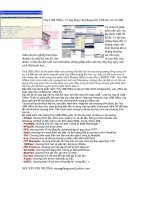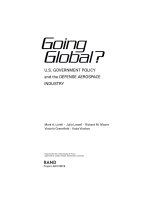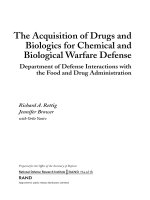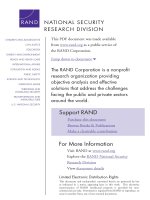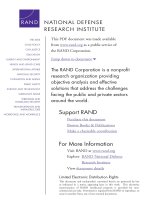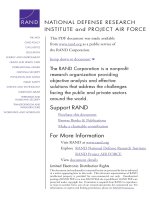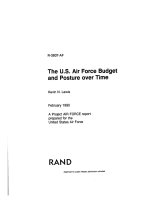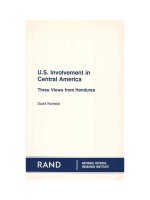Fostering closer ties u s interactions with singapore 1898 1906
Bạn đang xem bản rút gọn của tài liệu. Xem và tải ngay bản đầy đủ của tài liệu tại đây (1.11 MB, 133 trang )
FOSTERING CLOSER TIES: US INTERACTIONS
WITH SINGAPORE 1898-1906
OH WEN-CI
B.A. (Hons.), NUS
A THESIS SUBMITTED
FOR THE DEGREE OF MASTER OF ARTS
DEPARTMENT OF HISTORY
NATIONAL UNIVERSITY OF SINGAPORE
2014
DECLARATION
I hereby declare that the thesis is my original work and it has been written by me
in its entirety. I have duly acknowledged all the sources of information which
have been used in the thesis.
This thesis has also not been submitted for any degree in any university
previously.
___________________________
Oh Wen-Ci
24 March 2014
ii
Acknowledgements
The process of churning out this thesis brought me closer to many people and I
am thankful for all the care and concern they showered upon me. First, I want to
express my love and appreciation for my family who have always been my pillar
of strength. It is thanks to their support that I have come so far.
I am immensely grateful to my supervisor, Dr Quek, who has always been
motivating me to do my best. With her guidance, I was able to widen my horizons
and learn more about history and historical thinking. Thanks for being so patient
with me, especially when I was having difficulties juggling this thesis with NIE
and school.
Other people I want to thank:
Prof Lockhart: for his care and concern when I was bogged down with work
Prof Huang Jianli: for helping me search for Chinese sources for my thesis.
Dr Michael Montesano: for his invaluable comments about my research
Jim Baker and his wife Junia: for taking the time to hear me out and
providing constructive suggestions
Mr Tim and his team in NUS Library: thank you for all your help in tracking
down my sources! You guys are the best!
Staff at NARA: for helping me bring out my old and dusty documents, and
giving me great advice. I miss your cheerful smiles!
Jenny Ng at the Methodist Archives: thank you for your kind assistance in
tracking down sources for me.
I must also express my thanks to my lovely friends who have been through the
roller coaster ride with me all this while. To my friends in the graduate room,
Cheryl, Huilin, Celisa, Jermaine, Eunshil, Kunyi, Lee Min, Cao Yin, Siriporn,
Brandon, Aidil and Edgar, thanks for all the fun and laughter! To my friends Rui
Ping, Edeline, Beatrice, Amelia, George, XiLei, Jin Xun, Shi Xian and Arunima,
thanks for always being there for me and cheering me up when I feel down.
Last, but definitely not the least, thank you Gabriel, for the listening ear, the
unbiased comments, the great advice, and unwavering support that you never
fail to provide! Thanks for always being by my side
iii
Table of Contents
Summary
Introduction
I.
The United States and the Pacific before 1898
II.
The Spanish-American War of 1898
III.
The British Colony of Singapore
IV.
Literature Review
V.
Structure of the Thesis
1
1
4
6
9
15
Chapter One: Winds of Change
I.
Pratt and the “Splendid Little War”
II.
Sir Frank Swettenham’s Report
III.
Merchants and Missionaries
IV.
Conclusion
17
18
27
38
44
Chapter Two: Turmoil at the Turn of the Century
I.
The ‘Quadrangular’ Relationship
II.
The Philippine Link in US-Singapore Interactions
III.
Spreading Methodism to the Philippines
IV.
Trade and Other Consular Matters
V.
Conclusion
45
46
50
55
58
64
Chapter Three: Growing Connections
I.
Singapore and the Philippine Experiment
II.
The Expansion of the Methodist Mission
III.
Regional and International Influences in US-Singapore Trade
IV.
Williams and the Singapore Consulate-general
V.
Conclusion
65
66
69
72
82
85
Chapter Four: The Chinese Boycott
I.
Economic Impact of the Boycott
II.
Methodist Schools and the Chinese Boycott
III.
The Boycott and US-Singapore Political Ties
IV.
Conclusion
87
88
94
98
101
Conclusion
103
Bibliography
114
iv
Summary
Little has been written about US-Singapore interactions before World
War I and this thesis aims to shed light on the relationship between the United
States and Singapore during the years 1898-1906. My study positions USSingapore ties within the larger context of regional and international events and
studies the changes in US interactions with Singapore during this period. The
years 1898-1906 marked a transitional period for US-Singapore ties with
Singapore as there were wide-ranging changes in commercial and diplomatic
exchanges between the United States and Singapore as well as in American
missionary activity in Singapore.
This thesis shows that these changes were largely propelled by wider
regional events during this period, such as the Spanish-American War, the
Philippine-American War and its aftermath, and the Chinese boycott of American
goods. These regional developments forged new and complex links between the
United States and Singapore and in doing so, fostered closer ties between them.
The role of the US consul-general in Singapore in this relationship will also be
examined.
Starting with the Spanish-American War in 1898, the United States was
drawn to the Pacific region and its presence in the region started to grow.
Singapore became involved in the Spanish-American War because of the actions
of the US consul-general in Singapore. His actions were to have significant
v
ramifications for the course of the war. The subsequent acquisition of the
Philippines after the war meant that the United States had a stake in the Pacific
and was obliged to protect its interests. As the role of the United States in the
Pacific started to change, US-Singapore interactions were influenced as well.
These international developments would help shape US perceptions of Singapore
and affect how American officials, businessmen and missionaries interact with
merchants and British colonial authorities in Singapore.
By 1905, stability was slowly restored to the Philippines but another
international event came to dominate US-Singapore interactions. The Chinese
boycott of American goods in 1905 originated from Shanghai but spread to the
overseas communities in the Pacific, including Singapore. The impact of the
Chinese boycott on US-Singapore ties will be explored in this thesis. By the end of
1906, the relationship between the United States and Singapore was no longer
the same as that in 1898 as the nature of their interactions had changed during
this period.
vi
Introduction
The United States and the Pacific before 1898
In the 1850s, US politician William Seward predicted, “European thought,
European commerce, and European enterprise…will nevertheless relatively sink
in importance in the future, while the Pacific Ocean, its shores, its islands, and
adjacent territories will become the chief theatre of human events and activities
in the world’s great hereafter.”1 Since few shared his views at that time, Seward’s
words went unheeded. Four decades later, American expansionists would quote
his statements to bolster their arguments for acquiring a colony in the Pacific.2
The relationship between the United States and the Pacific region dates
back to the late eighteenth century, when American vessels sailed to China in
search of trade opportunities. The American merchants often took the eastbound
route across the Atlantic Ocean, around the Cape of Good Hope, to ports in the
Indian Ocean, the East Indies and finally Canton.3 The British colony of Singapore
lay along this route and its strategic location at the tip of the Straits of Melaka
made it a key port of call in the region. Founded by the British in 1819, Singapore
attracted many traders due to its free port status. Under British rule, Singapore
soon became a well-known trade emporium where the produce of the Malay
Anthony McGrew, “Restructuring Foreign and Defence Policy: The USA”, in Asia-Pacific in the
New World Order, ed. Anthony McGrew and Christopher Brook (London: Routledge, 1998), p.158.
2 Pekka Korhonen, Japan and Asia-Pacific Integration: Pacific Romances 1968-1996 (London:
Routledge, 1998), p.93.
3 Yap Chee Seng, “The Career of Joseph Balestier as an American Diplomat and Businessman in
Singapore, 1836-1852”, Honors Thesis, Department of History, National University of Singapore
(NUS), 1986, p.7.
1
1
Archipelago and goods of Europe, India and China were exchanged.4 By the
1830s, Singapore replaced Batavia as the hub of junk trade from China.5 Drawn
by the growing trade, the United States established a consulate in Singapore in
1836.6 At this time, the United States had only set up three consulates in
Southeast Asia: Singapore, Batavia and Manila.7 Singapore was undoubtedly an
important trading port but it was situated in an area that the United States
overlooked for most of the nineteenth century.8 The United States was slow to
turn their attention towards Island South-East Asia and this region remained
peripheral to US interests until the 1890s.
Before the 1890s, the United States was more preoccupied with domestic
developments such as westward expansion. The issue of slavery also absorbed
their attention during the American Civil War.9 However, events in the 1890s
directed US interest towards the Pacific. In 1893, Frederick Jackson Turner
wrote a paper entitled “The Significance of the Frontier in American History”,
which argued that the frontier experience helped shape distinctive American
characteristics. At a time when the 1890 census appeared to point toward the
closing of the continental frontier, Turner’s thesis lent support to the
increasingly expansionist US foreign policy that searched for new frontiers in the
Kwa Chong Guan, Derek Heng and Tan Tai Yong, Singapore: A 700-Year History – From Early
Emporium to World City (Singapore: National Archives of Singapore, 2009), p.103.
5 Ibid., p.111.
6 Despatches from US Consuls in Singapore 1833-1906 (hereafter cited as Despatches), 12 April
1837, (Microfilm), NUS Libraries.
7 This can be inferred from the dates of the despatches from US consuls in Batavia and Manila.
8 Pamela Sodhy, “United States Consuls in Singapore 1859-1880”, Journal of the Malayan Branch
of the Royal Asiatic Society (hereafter cited as JMBRAS), LVI, Part 1 (June 1983), p.12.
9 Ivan Musicant, Empire by Default: The Spanish-American War and the Dawn of the American
Century (New York: Henry Holt and Company, 1998), p.10.
4
2
Asia-Pacific to explore.10 Other key proponents of expansionism included Alfred
Thayer Mahan and Theodore Roosevelt. Mahan’s paper, “The Influence of Sea
Power upon History”, called for the expansion of the US Navy to protect their
economic interests abroad.11 Mahan’s views were shared by Roosevelt, a rising
politician who would become President in 1901.12 Roosevelt envisioned the
United States as a world power and was keen on extending US power to the
Pacific and other parts of the world.13
Moreover, by the 1890s, the US economy started producing far more than
the domestic market could absorb. Naturally, advocates of trade expansion
suggested exporting the surplus products to overseas markets. 14 The huge China
market dazzled American imagination, and both businessmen and politicians
saw it as the perfect solution to their problems. In early 1898, Charles Denby, the
US Minister to China, called for quick action to seize the opportunity that the
China market offered.15 This heightened the importance of the Pacific region,
which was perceived by US officials and merchants as the gateway to the fabled
China market. Amidst this backdrop of increasing US interest in the Pacific
region, the Spanish-American War broke out and US involvement in the AsiaPacific deepened as a result.
William Appleman Williams, “The Frontier Thesis and American Foreign Policy”, Pacific
Historical Review, 24, 4, (November 1955), pp.383-384; Michael H. Hunt, The Making of A Special
Relationship: The United States and China to 1914 (New York: Columbia University Press, 1983),
pp.143-168.
11 Musicant, Empire by Default, pp.7-8.
12 Korhonen, Japan and Asia-Pacific Integration: Pacific Romances 1968-1996, p.93.
13 Ibid.
14 Thomas G. Paterson, “American Businessmen and Consular Service Reform, 1890’s to 1906”,
The Business History Review, 40, 1 (Spring 1966), p.85; Richard Werking, The Master Architects:
Building the United States Foreign Service, 1890-1913, (Lexington: The University Press of
Kentucky, 1977), p.22.
15 H. W. Brands, Bound to Empire: The United States and the Philippines (New York; Oxford: Oxford
University Press, 1992, pp.9-10.
10
3
The Spanish-American War of 1898
The Spanish-American War was a watershed event in US foreign relations
as it propelled the United States across the Pacific. The war grew out of a
revolution in Cuba, which was then under Spanish rule. By the late 1890s, Spain
was in decline and its empire had dwindled to three colonies: Cuba, Puerto Rico
and the Philippines.16 In 1895, a group of Cuban nationalists renewed their fight
for independence and launched uprisings all across the island.17 The Cuban
insurgents carried out a scorched earth campaign, where they destroyed
sugarcane fields and destroyed railways, in order to drain every possible source
of Spanish revenue.18 Consequently, there was a sharp decline in sugar
production and the Cuban economy plunged into crisis.19 Cuban-American trade
was adversely affected and America investments of about $50 million went up in
smoke.20 Due to skilful propaganda by the Cuban junta in Washington and New
York, the insurrection in Cuba gained widespread sympathy and support from
the American public.21
The US political administration grew increasingly concerned over the
volatile situation in Cuba as well. In 1897, William McKinley succeeded Grover
Cleveland as US President. Desiring a peaceful end to the revolt in Cuba,
Richard Hines, “’First to Respond to Their Country’s Call’: The First Montana Infantry and the
Spanish-American War and Philippine Insurrection, 1898-1899”, Montana: The Magazine of
Western History, 52, 3 (Autumn, 2002), p.46.
17 Michael Golay, Spanish-American War, Updated Edition (New York: Infobase Publishing, 2009),
p.2.
18 Musicant, Empire by Default, p.50.
19 Ibid., p.57.
20 Lewis L. Gould, The Spanish-American War & President McKinley (Kansas: University Press of
Kansas, 1982), p.24.
21 Ibid., p.20.
16
4
McKinley turned up the diplomatic heat on Spain by threatening to accord
belligerent rights to Cuba.22 When Praxedes M. Sagasta took over as Prime
Minister of Spain, the new Spanish regime responded positively to US overtures
and eventually granted autonomy to Cuba.23 Yet relations between the United
States and Spain took a turn for the worst in January 1898. Riots broke out in
Havana, when pro-Spanish loyalists and army personnel protested against
Cuba’s autonomy.24 In response, McKinley ordered the battleship USS Maine to
Havana to demonstrate concern and to protect American citizens.25 On 15
February 1898, the Maine exploded in Havana harbour, killing 266 American
officers and crew. This incident escalated the tensions between Spain and the
United States as much of the American public believed that Spain was
responsible for the sinking of the Maine.26 Over the next few months, diplomatic
overtures made little progress. Finally on 19 April 1898, Congress declared Cuba
free and independent, and directed the President to employ military force to
remove Spanish authority.27 Five days later, Spain declared war against the
United States.
The first major engagement of the Spanish-American War took place in
Manila Bay in the Philippines. As early as 26 February 1898, Commodore George
Dewey, Commander-in-chief of the US Asiatic Squadron, had received orders that
in the event of war he was to ensure that the Spanish navy did not leave the
John Offner, “McKinley and the Spanish-American War”, Presidential Studies Quarterly, 34, 1
(March 2004), p.54.
23 Musicant, Empire by Default, p.30.
24 Golay, Spanish-American War, Updated Edition, p.xvii.
25 Offner, “McKinley and the Spanish-American War”, p.56.
26 Hines, “’First to Respond to Their Country’s Call’: The First Montana Infantry and the SpanishAmerican War and Philippine Insurrection, 1898-1899”, p.47.
27 Ibid., p.48.
22
5
Asiatic Coast.28 Dewey proceeded to assemble his forces at Hong Kong and made
preparations for war. On 27 April 1898, Dewey was informed that war had
started between the United States and Spain, and he was directed to the Spanish
colony of the Philippines to attack the Spanish fleet.29 On the morning of 1 May
1898, the US Asiatic Squadron sailed into Manila Bay, where they engaged and
destroyed the Spanish navy. This victory prompted the McKinley administration
to send troops to wrest Manila from Spanish control.30 Meanwhile, Spain faced
similar defeats in the Caribbean and it was a matter of time before Spain sued for
peace. As a result of the war, the United States acquired the Philippine Islands
and became a colonial power. The possession of a colony in the Pacific meant
that the role of the United States in the region had shifted from an interested
observer of Asian affairs into a proprietary player.31 As the United States became
more involved in the Pacific region, Singapore engaged their attention as well
since it was widely recognised as the premier port in Southeast Asia.32
Singapore’s importance in the region meant that US presence in Singapore was
indicative of American interest in the Asia-Pacific.
The British Colony of Singapore
As the port of Singapore grew and flourished over the years, there were
several changes in the administration of the colony. Shortly after its founding,
Singapore became integrated with Penang and Malacca to form the Straits
Musicant, Empire by Default, p.193.
Derek Granger, “Dewey at Manila Bay”, Naval War College Review, 64, 4 (September 2011),
p.134.
30 Ibid., p.136.
31 Brands, Bound to Empire: The United States and the Philippines, p.vii.
32 Wong Lin Ken, “Singapore: Its Growth as an Entrepot Port, 1819-1941”, Journal of Southeast
Asian Studies, 9, 1 (March 1978), p.54.
28
29
6
Settlements in 1826.33 In 1830, the Straits Settlements was brought under the
Presidency of Bengal in India and later in 1851, the Governor-General of India
assumed direct control over the Straits Settlements.34 But the deficiencies of
British India’s administration prompted Singapore’s merchant community to
petition for direct rule under London.35 After a decade of negotiations, the Straits
Settlements was finally made a crown colony in 1867.36
The opening of the Suez Canal in 1869 further enhanced Singapore’s
commercial significance to the British Empire.37 The Suez route ensured
Singapore’s geographical supremacy since the Straits of Malacca replaced the
Sunda Straits as the major waterway from Europe to the Far East.38 Moreover,
with the development of steamships in merchant shipping, Singapore became a
key coaling station for steamships to replenish their supplies.39 Consequently,
the volume of Singapore’s trade expanded dramatically, showing an eightfold
increase from 1873 to 1913.40 The nature of Singapore’s trade also shifted from
exotic wares such as porcelain, tea and fabrics, to primary products of rubber
and tin.41 While the prosperity of British firms was evident, a substantial section
of the wealth lay in the hands of the Chinese merchants in Singapore.42 This led
Constance Mary Turnbull, A History of Modern Singapore, 1819-2005 (Singapore: NUS Press,
2009), p.53.
34 Jean Abshire, The History of Singapore (Santa Barbara: Greenwood, 2011), p.58.
35 Turnbull, A History of Modern Singapore, 1819-2005, pp.86-87.
36 Ibid., p.89.
37 George Bogaars, “The Effect of the Opening of the Suez Canal on the Trade and Development of
Singapore”, JMBRAS, 42, 1 (July 1969), p.210.
38 Abshire, The History of Singapore, p.59.
39 Kwa, Heng and Tan, Singapore: A 700-Year History, p.103.
40 Turnbull, A History of Modern Singapore, 1819-2005, p.104.
41 Abshire, The History of Singapore, p.63.
42 Turnbull, A History of Modern Singapore, 1819-2005, p.107.
33
7
historian Mary Turnbull to comment that at the turn of the century, Singapore
was “largely an Anglo-Chinese preserve”.43
At this time, the population was largely made up of immigrants from
China and India, and there was no consciousness of a Singaporean identity.44 The
majority of the population intended to return to their homeland after making
their fortune. Still, some of these migrants would eventually remain and
permanently settle in Singapore. By the late nineteenth century, the Chinese
community formed the majority of the population in Singapore.45 The
overwhelming dominance of the Chinese, coupled with their key roles in the
Singapore economy as labourers or merchants, made them a significant group
with considerable influence in Singapore.46 Hereafter, in this thesis, the term
“Singapore” refers to the British colonial port, where a large Chinese immigrant
community resided.
Whereas economic profits were shared by British and Chinese merchants,
political power remained in the hands of the British. In particular, control of
political affairs was concentrated in the hands of the Governor of the Straits
Settlements.47 Sir Charles Mitchell was appointed the Governor in 1894, despite
having no experience in the Straits.48 In 1896, with the creation of the Federated
Malay States, the Governor of the Straits Settlements also became High
Ibid., p.125.
Ibid., p.93.
45 Abshire, The History of Singapore, p.46.
46 Ibid., p.50.
47 Turnbull, A History of Modern Singapore, 1819-2005, pp.94-95.
48 H.S. Barlow, Swettenham (Kuala Lumpur: Southdene, 1995), p.446.
43
44
8
Commissioner of the Federation.49 Upon his death in 1899, James Alexander
Swettenham took over as Acting Governor until his brother Frank Swettenham
became the Governor in 1901.50 Frank Swettenham was renowned for his
knowledge pertaining to Malay affairs and his appointment reflected how
important Singapore had become to the Colonial Office.51 In 1904, Swettenham
was succeeded by Sir John Anderson, who had served twenty-five years in the
Colonial Office and had the complete confidence of the British government.52
Singapore’s strategic importance had increased over the years, as demonstrated
by the expanded powers of the Governor, as well as the political appointments.
US interactions with Singapore hence took place within this complicated colonial
framework. Generally, the Governor and the US consul-general had sufficient
autonomy to settle most issues between them, though the British Colonial Office
and the US State Department would interfere in the case of urgent or serious
matters.
Literature Review
US-Singapore interactions in the pre-1945 period have not paid much
attention to the years 1898-1906. Scholars like Shakila Yacob and Jim Baker
consider the interwar years as the time of change in US interactions with
Singapore and similarly, Wong Lin Ken tends to point out World War I as the
Barbara Watson Andaya, A History of Malaysia, 2nd Edition (Basingstoke: Palgrave, 2001),
p.187.
50 Barlow, Swettenham, p.491.
51 Ernest Chew, “Sir Frank Swettenham and the Federation of the Malay States”, Modern Asian
Studies, 2, 1 (January 1968), p.168.
52 Turnbull, A History of Modern Singapore, 1819-2005, p.109.
49
9
defining moment that brought about changes in US-Singapore trade.53 However, I
argue that the period 1898-1906 is another significant transitional phase in USSingapore interactions. This thesis hopes to redress this gap in existing literature
by studying this overlooked period of change.
My research focuses on the period 1898-1906 and examines how regional
and international developments effected varied and extensive changes in
political, economic and social ties between the United States and British
Singapore. The Spanish-American War marked the start of this period of change
as the shift in US role in the Pacific influenced American interactions with
colonial Singapore. By 1899, acquisition of the Philippines resulted in an
expanded quadrangular relationship encompassing the United States, Britain,
and the colonies of Singapore and the Philippines. The Philippine-American War
added complexity to the evolving connections between the United States and
Singapore. The 1905-1906 Chinese boycott of American products was another
international event that heightened Washington’s awareness of Singapore’s
rising importance.
My study ends in 1906 when the US consular service was
professionalised. A consular reorganisation bill was passed by Congress on 5
April 1906 and consular officers were reclassified under a new system.54 The bill
Shakila Yacob, The United States and the Malaysian Economy (London; New York: Routledge,
2008), p.34; Jim Baker, The Eagle in the Lion City: America, Americans and Singapore (Singapore:
Landmark Books, 2005), pp.136-7; Wong, “Singapore: Its Growth as an Entrepot Port, 18191941”, pp.69-84; although Yacob’s book is primarily on US-Malaya relations, US interactions with
Singapore can be extrapolated from her work.
54 Charles Stuart Kennedy, The American Consul: A History of the United States Consular Service
1776-1914 (New York: Greenwood Press, 1990), p.219.
53
10
also established consular inspection corps and required each post to be
inspected every two years.55 Up till 1906, the US consular service was allegedly
staffed with amateurs, rogues, and inept officials and there were many scandals
involving the consuls.56 The reform of the US consular service marks the end of
the transitional period as the United States decided to have a more systemic and
effective consular service to manage their overseas interests. The impact of the
consular reforms on US interactions with Singapore requires further analysis
beyond the scope of this thesis.
One of my key sources pertaining to diplomatic interactions between the
United and Singapore is the Despatches from United States Consuls in Singapore,
official communications from the US consul-general at Singapore to the Assistant
Secretary of State in Washington. Among this collection of records, there is a
detailed report on British administration of the Malay States written by Frank
Swettenham, who was the Resident-General of the Federated Malay States at that
time. Swettenham wrote it upon a request by the US consul-general in Singapore
and a section on British governance of Singapore was included in the document.
This source has not surfaced in existing scholarship as it resides within the
American consul despatches and is not found in the British archives, where most
of Swettenham’s papers are located.
However, the Despatches are uni-directional and only offer one side of the
correspondence. To supplement this collection of documents, RG 84: Records of
Ibid.
Eileen Scully, “Taking the Low Road to Sino-American Relations: “Open Door” Expansionists
and the Two China Markets”, Journal of American History, 82, 1 (Jun 1995), p.71.
55
56
11
the Foreign Service Posts of the Department of State, 1788-ca. 1991, held at the
National Archives and Records Administration (NARA), is useful in supplying the
other side of the correspondence. RG 59: General Records of the Department of
State, 1756-1999, held at NARA, is also valuable to my work as it holds an
assortment of correspondence between the US consul-general and British
colonial officials in Singapore, as well as merchants from the United States and
Singapore.
Trade figures pertaining to Singapore and the United States are obtained
from the Straits Settlements Blue Books and Straits Settlements Annual Reports,
and these colonial reports help to paint a clearer picture of the economic
exchanges between the United States and Singapore. In addition, Commercial
Relations of the United States with Foreign Countries, which is a compilation of the
annual reports of US consular officers, provides a different set of statistics for
analysis. The abovementioned sources paint a picture of the official relations
between the United States and Singapore. But the unofficial representations are
also equally important. My sources also include newspapers such as the
Singapore Free Press, The Straits Times, Lat Pau, New York Times, Washington
Post and Manila Times. Furthermore, the Minutes of Meetings of the Annual
Malaysia Conference of the Methodist Episcopal Church and The Malaysia
Message, a Methodist publication, were useful in providing information on
Methodist missionary activity in Singapore, Malaya and the Philippines.
My focus on the three aspects of diplomatic interactions, commercial
exchanges and missionary activities is framed by the diffused nature of sources
12
on US-Singapore ties during 1898-1906. The scarcity of literature on USSingapore interactions in the pre-1945 period is likely because of how Singapore
has often been “treated as an integral part of the Straits Settlements or British
Malaya”.57 Due to their intertwining history, many historians, including Pamela
Sodhy and Shakila Yacob, tend to subsume US-Singapore interactions under USMalaya relations. Sodhy’s The US-Malaysian Nexus: Themes in Superpower-Small
State Relations posits that before 1945, colonial Malaya was confined to a passive
role in the triangular relationship with the United States due to strong British
political control over the Malay States.58 Sodhy’s focus was on the political
relationship between the United States and British Malaya, and she incorporated
US-Singapore interactions into her work. On the other hand, Yacob’s book
concentrates exclusively on the economic ties between the United States and
colonial Malaya, and offers an in-depth study of how the British facilitated US
trade and investment in both Singapore and Malaya. While Sodhy and Yacob
ascribes passivity to British Malaya’s role in its relationship with the United
States before 1945, my research shows the opposite. In 1905, the Chinese
community in Singapore, as well as in Malaya, displayed agency in boycotting
American goods to demonstrate their unhappiness with US immigration laws.
Theodore Doraisamy and Earnest Lau also chose to not to separate these
two territories in their studies on American Methodists in Singapore and
Wong, “Singapore: Its Growth as an Entrepot Port, 1819-1941”, p.50
Pamela Sodhy, The US-Malaysian Nexus: Themes in Superpower-Small State Relations (Kuala
Lumpur: Institute of Strategic and International Studies, Malaysia, 1991), p.40.
57
58
13
Malaysia.59 Both Doraisamy and Lau delved into the spread of Methodism not
just in Singapore and Malaysia, but also the Philippines and Indonesia, to
highlight the international nature of their mission. Although they touched on the
connections between the Philippine Mission and the Singapore Mission, the links
between the United States, the Philippines and colonial Singapore were not
clearly drawn since it was not their intention to do so. Hence my dissertation
expands on their work by exploring the missionary aspect of US-Singapore
interactions. My study will also look at how the acquisition of the Philippines
after the Spanish-American War had a significant impact on the development of
the Singapore Mission.
However, the relationship between the United States and Singapore in the
pre-1945 period can also be studied on its own as Singapore’s economy,
government and population were distinct from that of the Malay Peninsula. This
is illustrated in works on US-Singapore interactions by Sharom Ahmat, Yap Chee
Seng and Wong Lin Ken.60 In particular, Wong’s article provides an extensive
historical survey of US-Singapore trade connections from 1819-1941. While he
takes into account the influence of several external events on Singapore’s
economy, Wong does not make any reference to regional events in the
Philippines nor China. This neglect is symptomatic of existing studies in USSingapore interactions and likewise, Sodhy and Yacob tend to neglect the wider
Theodore R. Doraisamy, The March of Methodism in Singapore and Malaysia, 1885-1980
(Singapore: Methodist Book Room, 1982); Earnest Lau, From Mission to Church: The Evolution of
the Methodist Church in Singapore and Malaysia, 1885-1976 (Singapore: Genesis Books, 2008).
60 Sharom Ahmat, “Joseph B. Balestier: First American Consul at Singapore, 1833-1852”, JMBRAS,
XXXIX (December, 1966), pp.108-122; Sharom Ahmat, “American Trade with Singapore, 181965”, JMBRAS, XXXVIII, 2, (December 1965), pp.241-257; Yap, “The Career of Joseph Balestier as an
American Diplomat and Businessman in Singapore, 1836-1852”, Honors Thesis, Department of
History, NUS, 1986; Wong, “Singapore: Its Growth as an Entrepot Port, 1819-1941”, pp.50-84.
59
14
international context of the Philippines and China that helped shape changes in
US-Malayan interactions.
Jim Baker’s recent book on US interactions with Singapore is one of few
works that briefly discusses the Spanish-American War and the boycott of
American goods.61 Nevertheless, Baker merely describes the events and does not
explicate the impact of these developments in changing the relationship between
the United States and Singapore. Furthermore, he does not mention the
Philippine-American War and its role in framing US connections with Singapore.
Little research has been done on the broader international context surrounding
US-Singapore interactions and my thesis fills in this gap in existing literature by
studying the US-Singapore relationship within the wider context of
developments in the Philippines as well as China during the years 1898 to 1906.
Structure of the Thesis
This thesis is organised in chronological order to best demonstrate the
unfolding of international and regional events that influenced US-Singapore
interactions. The chapters are divided according to the periods that the various
US consul-generals at Singapore took office. This arrangement allows the actions
of the US consul-general, the prime American representative in Singapore, to be
examined.
The first chapter will look at how the Spanish-American War sparked a
series of changes in US-Singapore interactions in 1898. The actions of the US
61
Baker, The Eagle in the Lion City, pp.99-101, 110-114.
15
consul-general in Singapore are particularly important as it was to have
significant ramifications for the relationship between the United States and
Singapore. The second chapter proceeds to study how the initial stages of the
Philippine-American War changed the dynamics of US-Singapore ties during
1899-1900. This period will show how the US was grappling with its changing
role in the Pacific region, and the implications this held for Singapore. The
acquisition of the Philippines also diverted the attention of the Methodists from
Singapore to Manila, and these changes will also be explored.
The last stages of the Philippine-American War will be examined in the
third chapter, which will cover the years 1901-1904. As stability was slowly
established in the Philippines, other external events came to shape the evolving
relationship between the United States and Singapore as well. The fourth chapter
delves into the Chinese boycott of American goods in 1905. The development of
the Chinese boycott in Singapore and the effects of the boycott on US-Singapore
interactions will be studied in this section. Through these regional and
international events, closer ties between the United States and Singapore were
fostered.
16
Chapter One: Winds of Change
During the nineteenth century, Singapore was of peripheral interest to the
United States especially since Asia was considered “a backwater of American
diplomacy”.62 To officials and policymakers in Washington, Europe was always
accorded a higher priority and this attitude is reflected in how the most
prestigious US diplomatic posts were in European capitals and not in Asia.63
Even within Asia, Singapore was often marginalised as US attention was largely
focused on China.64 Despite the fact that American trade with China in 1897 was
“less than two per cent of its total foreign trade”,65 the “magic figure of four
hundred million customers” enchanted American merchants and politicians and
gave the China market an inflated importance beyond the reality of commerce
involved.66 Washington was also more interested in Siam (Thailand) than
Singapore, as Siam was the only country in Southeast Asia not colonised by
European powers.67 However, because of the Spanish-American War in 1898,
American policymakers, officials, businessmen and missionaries began to pay
more attention to Singapore. This chapter will examine how the SpanishAmerican War brought about these changes by contrasting the years before 1898
with the period during and after the war.
Benjamin A. Batson, “American Diplomats in Southeast Asia in the Nineteenth Century: The
Case of Siam”, Journal of the Siam Society, 64, 2 (July 1976), pp.41-42
63 Sodhy, “United States Consuls in Singapore 1859-1880”, p.12.
64 James C. Thomson, Peter W. Stanley and John Curtis Perry, Sentimental Imperialists: The
American Experience in East Asia (New York: Harper & Row, 1981), p.31.
65 Julius W. Pratt, “American Business and the Spanish-American War”, The Hispanic American
Historical Review, 14, 2 (May 1934), p.186.
66 A.E. Campbell, “Great Britain and the United States in the Far East, 1895-1903”, The Historical
Journal, 1, 2 (1958), p.163.
67 Batson, “American Diplomats in Southeast Asia in the Nineteenth Century”, p.41.
62
17
Pratt and the “Splendid Little War”
Spain and the United States went to war towards the end of April 1898.68
John Hay, then US Ambassador to London, described the conflict as a “splendid
little war”. Although the Spanish-American War in the Pacific theatre mainly took
place in the Philippines, Singapore’s central location allowed the US consulgeneral at Singapore, Edward Spencer Pratt, to gather valuable war intelligence.
Just before war broke out, the US State Department sent a circular to Pratt on 15
April 1898, directing him “to watch and report the movements of Spanish ships
of war” as they feared the Spanish government might “resort to privateering as a
means of increasing its offensive sea power”.69 But even before receiving the
circular, Pratt had sent a despatch to the State Department on 20 April 1898,
entitled “Importance of Singapore at the present juncture from the fact of its
being the port of call of Spanish steamers”. Pratt’s own assessment brought him
to the same conclusion that the movements of Spanish vessels could be
monitored from Singapore.70
Even before the war, Singapore’s strategic significance as a key port of call
was noted by US officials. For instance, on 2 July 1897, the State Department sent
a telegram to Pratt: “Cable if Japanese war ship Fuji arrives”.71 Construction of
the Fuji-Kan had just been completed in England and it was expected to set off
For a detailed account of the Spanish-American War, see David F. Trask, The War with Spain
1898 (New York: Macmillan, 1981); Stanley Karnow, In Our Image: America’s Empire in the
Philippines (New York: Ballantine Books, 1990); Leon Wolff, Little Brown Brother: How the United
States Purchased and Pacified the Philippine Islands at the Century’s Turn (Singapore: Oxford
University Press, 1991).
69 William R. Day, Assistant Secretary of State, 15 April 1898; Circulars of the Department of State
1797-1912; Administrative Records: Circulars, Regulations and Orders, Vol. 5; General Records of
the Department of State, Record Group 59 (RG 59); National Archives at College Park, MD(NACP).
70 Despatches, 20 April 1898.
71 Despatches, 3 July 1897.
68
18
for Japan thereafter.72 Washington was worried that the Japanese fleet would
intervene in Hawaii, since Japan had protested strongly against the signing of the
annexation treaty between the United States and Hawaii in June 1897.73
Nevertheless, the Fuji-Kan did not deviate from its route and on 9 October 1897,
Pratt cabled the State Department: “War ship Fuji arrived [at Singapore]”.74 A
separate despatch was sent on the same day, reporting that the Fuji-Kan would
“go on to Hong Kong and, after making a short stay there, proceed … to
Yokosuka”.75 On 8 November 1897, another Japanese warship docked at
Singapore and Pratt informed the State Department accordingly: “… [YashimaKan] is expected, after coaling, to proceed to Hongkong and thence on to her
destination in Japan”.76 Such reports on the movements of vessels, prior to 1898,
were often limited to single ships and generally included the dates of arrival at
and departure from Singapore, as well as the next destination.
The advent of the Spanish-American War was to intensify and expand the
existing intelligence gathering efforts of the US consulate at Singapore. On 3 May
1898, Pratt wrote to the State Department:
I have the honor to submit for your consideration certain interesting
particulars regarding Spanish Cruisers and Mail Steamers and Coal
Deposits, Armament, Cable, Railways, etc. in the Philippines, which I
succeeded in obtaining here and supplied to Commodore Dewey
previous to his departure from Hong Kong, in addition to more urgent
information concerning movements of ships, mining of channels,
relieving of garrisonal posts…77
The Straits Times, 7 April 1897.
William Reynolds Braisted, The United States Navy in the Pacific, 1897-1909 (Austin: University
of Texas Press, 1958), p.13.
74 Despatches, 9 October 1897.
75 Ibid.
76 Despatches, 8 November 1897.
77 Despatches, 3 May 1898.
72
73
19
